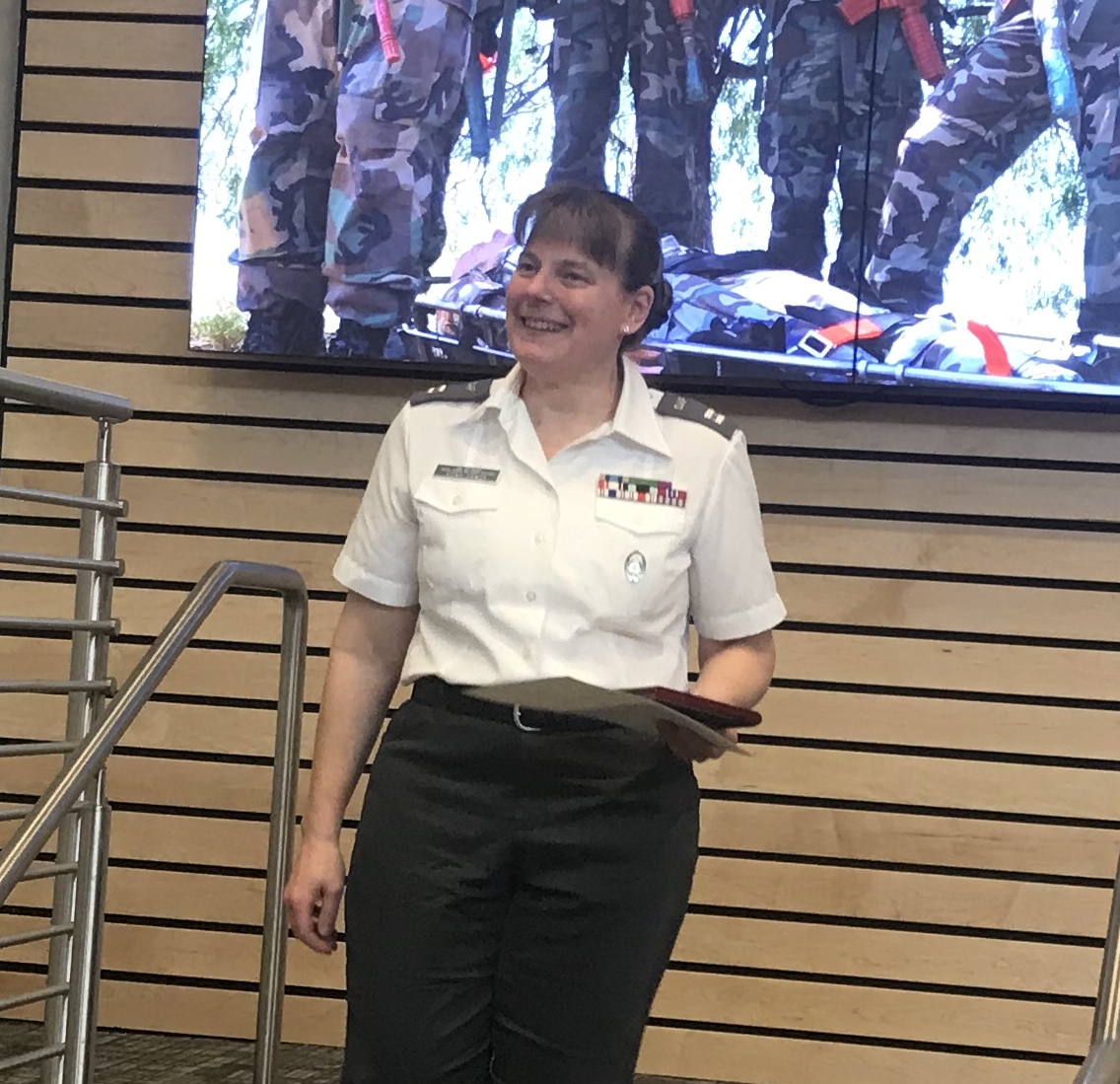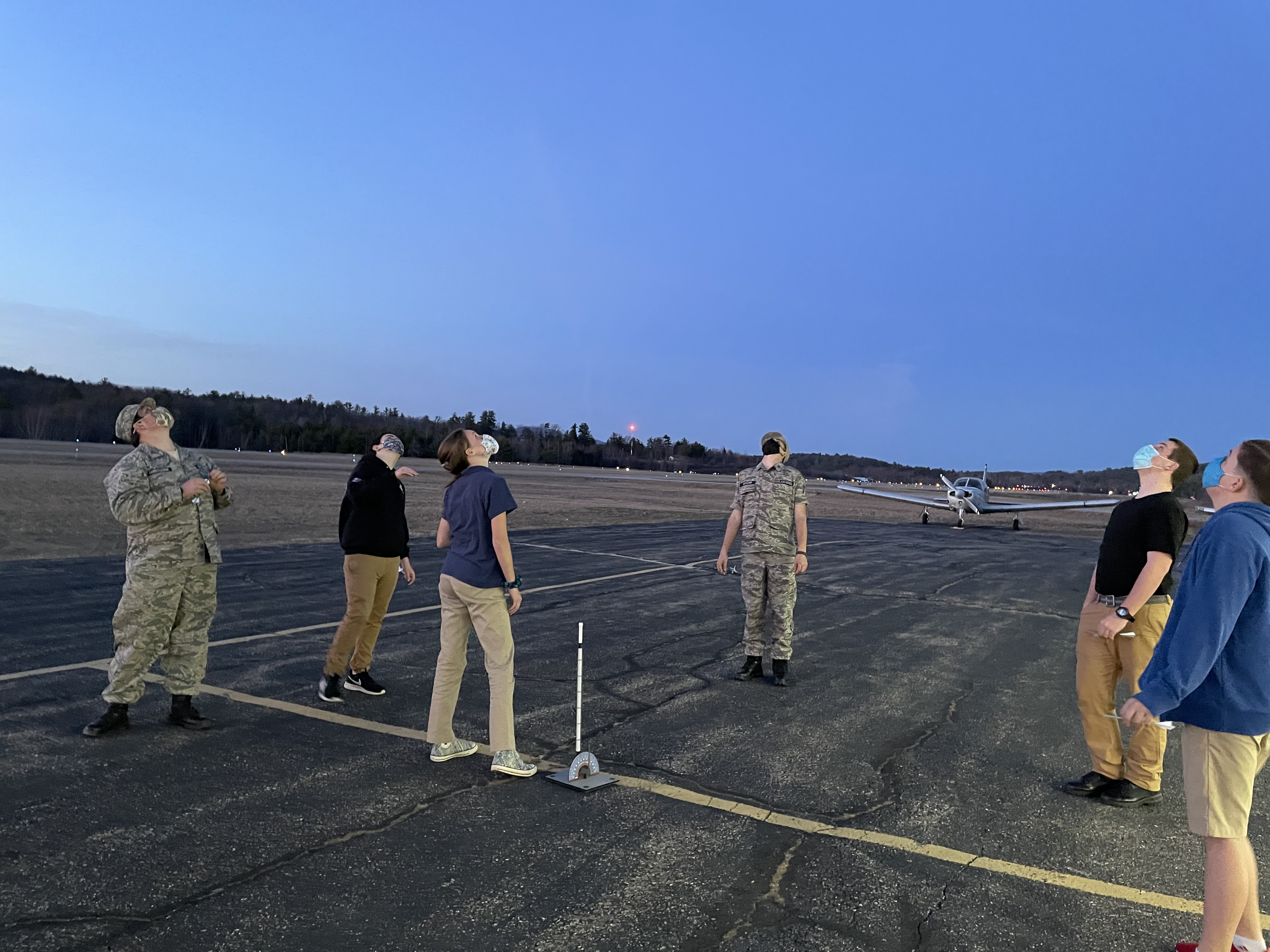Capt. Julie Sicks-Panus of New Hampshire is both an AEO and a K-8 STEM educator
Posted on May 13, 2021 at 9:34 AM by Virginia Smith
 |
| Capt. Julie Sicks-Panus is both a squadron AEO and a K-8 STEM teacher. |
May 13, 2021
Meet Capt. Julie Sicks-Panus. She is the Aerospace Education Officer for Hawk Composite Squadron in Laconia, New Hampshire (NER-NH-056). Capt. Sicks-Panus, who is also an assistant Director of Aerospace Education (DAE) for the New Hampshire Wing, joined CAP six years ago about a year after her son joined CAP as a cadet. In addition to her CAP career, she also is a veteran elementary school teacher. She has been the K-8 STEM teacher/specialist for Plymouth Elementary School for the past 23 years. She is a member of the International Technology and Engineering Educators Association (ITEEA) and has been recognized by that group as a "Leader to Watch." Whether it be working with cadets or working with her younger elementary students, she enjoys mentoring in AE/STEM. "AE is fun and engaging for all ages," she says. "It gives an exciting basis to teach scientific principles and explore engineering practices." Her teaching aerospace engineering lessons not only has had an impact on her students, but also on Capt. Panus-Sicks. It inspired her to begin flying lessons. We asked her some questions about CAP and her teaching career, and her answers follow.
How did you get involved in Civil Air Patrol?
My son thought he might like to go into an aviation-related field, and our school IT director at the time was involved with Hawk Squadron, my son went on to earn his Mitchell Award, but has since left CAP, but I have stayed!
Tell us about your CAP career highlights.
I have developed aerospace lessons for CAP cadets, taught all the Aerospace Education Modules, worked with the New Hampshire Wing Aerospace Weekend to teach model rocketry and presented aerospace workshops at the annual New Hampshire Wing Conference. I also presented information on CAP resources through the AEM program to STEM Teacher colleagues at the Annual ITEEA Conferences. I have earned my Master Rating as a CAP Aerospace Officer and the Yeager Award. In 2017, I was was named the New Hampshire Air Force Association Aerospace Educator of the year. In 2018, I was selected as New Hampshire Civil Air Patrol Aerospace Education Officer of the Year.
Tell us about your career outside of Civil Air Patrol.
I am the K-8 STEM teacher/specialist for Plymouth Elementary School. I developed the program from the more traditional industrial arts/tech ed program that I inherited into the state of the profession integrated STEM program that it is now. I work with classroom teachers to identify concepts and theories that I then target with engineering design challenges. I also meet with students on a different schedule than their classroom teachers in order to weave together the content and skills the students need when they present to experts during their STEM Showcase each spring.
Additionally, I designed and implemented the K-5 STEM program at Plymouth. This has been a highlight of my career and a reward that I thrive on to see the joy and confidence the younger students experience when they "make it work!"
During the past six summers, I have taught aerospace for a WinnAero ACE Academy, a local aerospace summer camp started by fellow CAP senior member, 2nd Lt. Dan Caron. Teaching a Space Exploration Week and Middle School Aerospace Engineering sessions has inspired me to begin taking flight lessons. Learning something completely new and different as an adult pushes my capabilities and comfort level. It gives me a renewed appreciation for how my students approach learning something new.
Tell us about awards and recognition you'd like to mention.
- Was selected as the New Hampshire Civil Air Patrol Aerospace Education Officer of the year in 2018
- Was named the New Hampshire Air Force Association Aerospace Educator of the Year in 2017
- Was recognized as a "Leader to Watch" by International Technology and Engineering Educators Association (ITEEA) in 2020
- The Plymouth Elementary School STEM program was recognized as a STEM Program of Excellence at the 2018 ITEEA Annual Conference
- Was honored with the ITEEA William J. Wilkinson Meritorious Service Award (Commendation for Excellence of Service to the Association and to the Profession) in 2021

Capt. Sicks-Panus was awarded the New Hampshire Wing AEO of the year in 2018.
How have COVID restrictions impacted your AEO and classroom lessons?
COVID restrictions are the most difficult thing I have had to deal with in my teaching career -- primarily because, although my school has met in person (face-to-face) all through the '20-'21 school year, we were distanced (6 feet apart) and could not share tools or materials. Normally, cooperative and group work is a mainstay of my program! My classes and our CAP Squadron were also remote. While we were remote, I worked to find information, videos and challenges the cadets could do at home, with the materials they had on hand. During squadron Zoom meetings, we would discuss the AE Modules and worked to make "Jeopardy" games with the information or Quizlet/Kahoot type quiz-games to challenge each other and to help cadets study for their AE tests. The up-side of this is that we are building a bank of quiz-games for future use for our cadets!
Why do you work in and encourage youth in the Aerospace Education mission area?
AE is fun and engaging for all ages, it gives an exciting basis to teach scientific principles and explore engineering practices. Most projects or activities can be scaled to use with young children (K-2) all the way up through high school. Using a similar hands-on portion to talk about, explore and learn different parts of the systems, or the same parts in more depth. For example, I use paper-plate planes with my kindergartners to practice cutting and fine motor skills needed to assemble the plane. Then we fly them and watch what happens. We talk about basic airport areas (ramp, taxiway, runway, etc.) The students learn that planes do NOT fly on the taxiways! And on the runways, only one plane at a time! With older students, we explore pitch, roll and yaw with the control surfaces. And no matter where we are or what we are doing, we stop to watch planes overhead (and I will look them up on FlightRadar24 to see what they are!)
Tell us about the Civil Air Patrol AE programs you use internally and externally.
I use a wide sampling of the information and activities from CAP in my classes, squadron meetings and aerospace summer camps. I have used several STEM Kits, including Rocketry, Flight Sim, Weather Station and Model Airplane. I use the curriculum materials on a regular basis, integrated into my own lesson plans and the Aerospace Dot-to-Dots are a favorite activity for my K-2 classes when they have extra time!
What's the best advice you have for a new AE officer working with cadets?
Don't expect cadets to enjoy sitting and listening to a lecture each week! That is so much like "school"! I work to have a small portion of AE Night, where we talk about the concepts and material they need, but then I strive to have a hands-on portion related to those concepts; take any and all hands-on activities and create a challenge. I rarely have them simply follow directions to build and end there. I have them follow directions to a point, then ask them to make it "better" somehow. I will occasionally give them directions to build something I know is only mediocre. I tell them this and then challenge them to make it better! Engaged learning can be messy, when cadets (or any students) are deeply engaged and building hands-on; it can seem chaotic and messy, but the results can be fantastic! Don't ever be afraid to admit you don't now something - but always be ready to help find the answer. I am not a pilot, but I love aerospace - I see my role as someone who gets them started and gets them excited, but I will readily admit I don't know it all. But I'm happy to help find the answers!
Do you have any suggestions for how to conduct outreach in schools (working with students and recruiting AEMs)?
Outreach is very difficult during COVID-times. Hearing about CAP and the benefits of being an AEM is best when it comes from someone the potential recruit can identify with. This is why I have endeavored to bring the AEM and CAP STEM Kit information to my fellow technology and engineering teachers at the International Technology and Engineering Educators Association (ITEEA) conferences. The two areas are a dovetail fit!
I am an active member of ITEEA, serving as the Treasurer for the Elementary STEM Council for the past five years, and presenting both regular sessions and an extended Pre-Conference workshop at the Annual Conferences for the past four years. Additionally, I was the Elementary Representative on the committee that worked to update and revise the ITEEA Standards for Technological and Engineering Literacy (STEL) in 2019.
Please tell an anecdote of a rewarding experience working with cadets and students.
First graders, flying their paper-plate planes they made for the first time ... the squeals of delight! I truly love when students or cadets whom I have helped get started follow a passion on a topic, pass me by and can turn around and teach me new things. Also, a former PES Student and CAP Cadet is now in Pensacola learning to fly jets for the NAVY! We are so proud of him!
 |
|
| Hawk Squadron cadets in New Hampshire work on a rocketry activity. |



